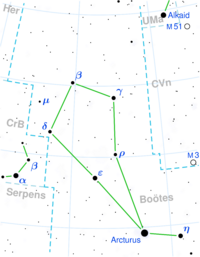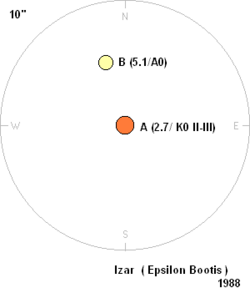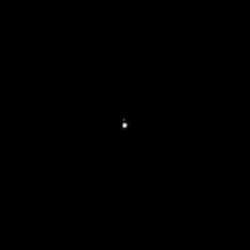Astronomy:Epsilon Boötis
Script error: No such module "About-distinguish".
| Observation data Equinox J2000.0]] (ICRS) | |
|---|---|
| Constellation | Boötes |
| Right ascension | 14h 44m 59.22s[1] |
| Declination | +27° 04′ 27.2″[1] |
| Apparent magnitude (V) | 2.37[2]/5.12[3] |
| Characteristics | |
| Spectral type | K0 II-III[4] + A2 V[5] |
| U−B color index | +0.73[2] |
| B−V color index | +0.97[2] |
| Astrometry | |
| Radial velocity (Rv) | −16.31[6] km/s |
| Proper motion (μ) | RA: −50.95[1] mas/yr Dec.: +21.07[1] mas/yr |
| Parallax (π) | 13.8267 ± 0.4896[7] mas |
| Distance | 236 ± 8 ly (72 ± 3 pc) |
| Absolute magnitude (MV) | −1.61[8] |
| Details | |
| A | |
| Mass | 4.6[9] M☉ |
| Radius | 33[6] R☉ |
| Luminosity | 501[6] L☉ |
| Surface gravity (log g) | 2.2[6] cgs |
| Temperature | 4,550[6] K |
| Metallicity | –0.13[6] |
| Metallicity [Fe/H] | –0.20[10] dex |
| Rotational velocity (v sin i) | 10.9[6] km/s |
| Age | 37.4 ± 4.2[11] Myr |
| B | |
| Mass | 2.27[12] M☉ |
| Radius | 2.7[12] R☉ |
| Luminosity | 44.8[12] L☉ |
| Surface gravity (log g) | 3.9[12] cgs |
| Temperature | 9,009[12] K |
| Rotational velocity (v sin i) | 123[13] km/s |
| Other designations | |
| A: Izar, HD 129989, HR 5506, SAO 83500[15] | |
| B: HD 129988, HR 5505[3] | |
| Database references | |
| SIMBAD | Epsilon Boo A |
| Epsilon Boo B | |
Epsilon Boötis (ε Boötis, abbreviated Epsilon Boo, ε Boo), officially named Izar (/ˈaɪzɑːr/ EYE-zar),[16] is a binary star in the northern constellation of Boötes. The star system can be viewed with the unaided eye at night, but resolving the pair with a small telescope is challenging; an aperture of 76 mm (3.0 in) or greater is required.[17]
Nomenclature
ε Boötis (Latinised to Epsilon Boötis) is the star's Bayer designation.
It bore the traditional names Izar, Mirak and Mizar, and was named Pulcherrima /pəlˈkɛrɪmə/ by Friedrich Georg Wilhelm von Struve.[18] Izar, and Mizar are from the Arabic: إزار ʾizār and مئزر Mi'zar ('kilt like undergarment') and المراق al-maraqq' ('the loins'); Pulcherrima is Latin for 'loveliest'.[19] In 2016, the International Astronomical Union organized a Working Group on Star Names (WGSN)[20] to catalogue and standardize proper names for stars. The WGSN approved the name Izar for this star on 21 August 2016 and it is now so entered in the IAU Catalog of Star Names.[16]
In the catalogue of stars in the Calendarium of Al Achsasi Al Mouakket, this star was designated Mintek al Aoua (منطقة العوّاء minṭáqa al awwa), which was translated into Latin as Cingulum Latratoris, meaning 'belt of barker'.[21]
In Chinese astronomy, 梗河 Gěng Hé ('Celestial Lance'), refers to an asterism consisting of Epsilon Boötis, Sigma Boötis and Rho Boötis.[22] Consequently, the Chinese name for Epsilon Boötis itself is 梗河一 Gěng Hé yī ('the First Star of Celestial Lance').[23]
Properties
Epsilon Boötis consists of a pair of stars with an angular separation of 2.852 ± 0.014 arcseconds at a position angle of 342.°9 ± 0.°3.[24] The brighter component (A) has an apparent visual magnitude of 2.37,[2] making it readily visible to the naked eye at night. The fainter component (B) is at magnitude 5.12,[3] which by itself would also be visible to the naked eye. Parallax measurements from the Hipparcos astrometry satellite[25][26] put the system at a distance of about 203 light-years (62 parsecs) from the Earth.[1] This means the pair has a projected separation of 185 Astronomical Units, and they orbit each other with a period of at least 1,000 years.[19]
The brighter member has a stellar classification of K0 II-III,[4] which means it is a fairly late-stage star well into its stellar evolution, having already exhausted its supply of hydrogen fuel at the core. With more than four times the mass of the Sun,[9] it has expanded to about 33 times the Sun's radius and is emitting 501 times the luminosity of the Sun.[6] This energy is being radiated from its outer envelope at an effective temperature of 4,550 K,[6] giving it the orange hue of a K-type star.[27]
The companion star has a classification of A2 V,[5] so it is a main sequence star that is generating energy through the thermonuclear fusion of hydrogen at its core. This star is rotating rapidly, with a projected rotational velocity of 123 km/s.[13] It has a surface temperature of about 9,000 K and a radius nearly three times the Sun, leading to a bolometric luminosity 45 times that of the Sun.
By the time the smaller main sequence star reaches the current point of the primary in its evolution, the larger star will have lost much of its mass in a planetary nebula and will have evolved into a white dwarf. The pair will have essentially changed roles: the brighter star becoming the dim dwarf, while the lesser companion will shine as a giant star.[19]
In culture
In 1973, the Scottish astronomer and science fiction writer Duncan Lunan claimed to have managed to interpret a message caught in the 1920s by two Norwegian physicists[28] that, according to his theory, came from a 13,000 year old satellite polar orbiting the Earth known as the Black Knight and sent there by the inhabitants of a planet orbiting Epsilon Boötis.[29] The story was even reported in Time (magazine) magazine.[30] Lunan later withdrew his Epsilon Boötis theory, presenting proofs against it and clarifying why he was brought to formulate it in the first place, but later revoked his withdrawal.[31]
References
- ↑ 1.0 1.1 1.2 1.3 1.4 van Leeuwen, F. (2007). "Validation of the new Hipparcos reduction". Astronomy and Astrophysics 474 (2): 653–664. doi:10.1051/0004-6361:20078357. Bibcode: 2007A&A...474..653V.
- ↑ 2.0 2.1 2.2 2.3 Johnson, H. L. et al. (1966). "UBVRIJKL photometry of the bright stars". Communications of the Lunar and Planetary Laboratory 4 (99): 99–110. Bibcode: 1966CoLPL...4...99J.
- ↑ 3.0 3.1 3.2 "HR 5506 -- Star in double system". SIMBAD. Centre de données astronomiques de Strasbourg. http://simbad.u-strasbg.fr/simbad/sim-basic?Ident=HR+5506+--+Star+in+double+system.
- ↑ 4.0 4.1 Luck, R. Earle; Wepfer, Gordon G. (November 1995). "Chemical Abundances for F and G Luminosity Class II Stars". The Astronomical Journal 110: 2425. doi:10.1086/117702. Bibcode: 1995AJ....110.2425L.
- ↑ 5.0 5.1 Cowley, A. et al. (April 1969). "A study of the bright A stars. I. A catalogue of spectral classifications". The Astronomical Journal 74: 375–406. doi:10.1086/110819. Bibcode: 1969AJ.....74..375C.
- ↑ 6.0 6.1 6.2 6.3 6.4 6.5 6.6 6.7 6.8 Massarotti, Alessandro et al. (January 2008). "Rotational and Radial Velocities for a Sample of 761 Hipparcos Giants and the Role of Binarity". The Astronomical Journal 135 (1): 209–231. doi:10.1088/0004-6256/135/1/209. Bibcode: 2008AJ....135..209M.
- ↑ Brown, A. G. A. (2021). "Gaia Early Data Release 3: Summary of the contents and survey properties". Astronomy & Astrophysics 649: A1. doi:10.1051/0004-6361/202039657. Bibcode: 2021A&A...649A...1G. Gaia EDR3 record for this source at VizieR.
- ↑ Anderson, E.; Francis, Ch. (25 May 2012). "XHIP: An extended hipparcos compilation". Astronomy Letters 38 (5): 331–346. doi:10.1134/S1063773712050015. Bibcode: 2012AstL...38..331A.
- ↑ 9.0 9.1 Gondoin, P. (December 1999). "Evolution of X-ray activity and rotation on G-K giants". Astronomy and Astrophysics 352: 217–227. Bibcode: 1999A&A...352..217G.
- ↑ Anders, F.; Khalatyan, A.; Chiappini, C.; Queiroz, A. B.; Santiago, B. X.; Jordi, C.; Girardi, L.; Brown, A. G. A. et al. (2019). "Photo-astrometric distances, extinctions, and astrophysical parameters for Gaia DR2 stars brighter than G = 18". Astronomy and Astrophysics 628: A94. doi:10.1051/0004-6361/201935765. Bibcode: 2019A&A...628A..94A.
- ↑ Tetzlaff, N.; Neuhäuser, R.; Hohle, M. M. (January 2011). "A catalogue of young runaway Hipparcos stars within 3 kpc from the Sun". Monthly Notices of the Royal Astronomical Society 410 (1): 190–200. doi:10.1111/j.1365-2966.2010.17434.x. Bibcode: 2011MNRAS.410..190T.
- ↑ 12.0 12.1 12.2 12.3 12.4 Stassun K.G. (October 2019). "The revised TESS Input Catalog and Candidate Target List". The Astronomical Journal 158 (4): 138. doi:10.3847/1538-3881/ab3467. Bibcode: 2019AJ....158..138S.
- ↑ 13.0 13.1 Royer, F. et al. (October 2002). "Rotational velocities of A-type stars. II. Measurement of v sin i in the northern hemisphere". Astronomy and Astrophysics 393 (3): 897–911. doi:10.1051/0004-6361:20020943. Bibcode: 2002A&A...393..897R.
- ↑ "CCDM J14449+2704AB". SIMBAD. Centre de données astronomiques de Strasbourg. http://simbad.u-strasbg.fr/simbad/sim-basic?Ident=CCDM+J14449%2B2704AB.
- ↑ "HR 5505 -- Star in double system". SIMBAD. Centre de données astronomiques de Strasbourg. http://simbad.u-strasbg.fr/simbad/sim-basic?Ident=HR+5505+--+Star+in+double+system.
- ↑ 16.0 16.1 "IAU Catalog of Star Names" (TXT). http://www.pas.rochester.edu/~emamajek/WGSN/IAU-CSN.txt.
- ↑ Monks, Neale (September 2010). Go-To Telescopes Under Suburban Skies. Patrick Moore's Practical Astronomy Series. Springer. p. 110. ISBN 978-1-4419-6850-0. https://books.google.com/books?id=waO6tUtfblsC&pg=PA110.
- ↑ Burnham's Celestial Handbook, Vol. 1, publ. Dover Publications, Inc., 1978
- ↑ 19.0 19.1 19.2 Kaler, James B.. "Izar". Stars. University of Illinois. http://stars.astro.illinois.edu/sow/izar.html.
- ↑ "IAU working group on star names (WGSN)". https://www.iau.org/science/scientific_bodies/working_groups/280/.
- ↑ Knobel, E. B. (June 1895). "Al Achsasi Al Mouakket, on a catalogue of stars in the Calendarium of Mohammad Al Achsasi Al Mouakket". Monthly Notices of the Royal Astronomical Society 55 (8): 429. doi:10.1093/mnras/55.8.429. Bibcode: 1895MNRAS..55..429K.
- ↑ 陳久金 (2005) (in zh). 中國星座神話. 台灣書房出版有限公司. ISBN 978-986-7332-25-7.
- ↑ "研究資源 – 亮星中英對照表" (in zh). http://www.lcsd.gov.hk/CE/Museum/Space/Research/StarName/c_research_chinengstars_h_l.htm.
- ↑ Prieur, J.-L. et al. (22 May 2008). "Speckle observations with PISCO in Merate – V. Astrometric measurements of visual binaries in 2006". Monthly Notices of the Royal Astronomical Society 387 (2): 772–782. doi:10.1111/j.1365-2966.2008.13265.x. Bibcode: 2008MNRAS.387..772P.
- ↑ Perryman, M. A. C. et al. (July 1997). "The Hipparcos Catalogue". Astronomy and Astrophysics 323: L49–L52. Bibcode: 1997A&A...323L..49P.
- ↑ Perryman, Michael (2010). The Making of History's Greatest Star Map. Astronomers' Universe. Heidelberg: Springer-Verlag. doi:10.1007/978-3-642-11602-5. ISBN 978-3-642-11601-8. Bibcode: 2010mhgs.book.....P. https://cds.cern.ch/record/1338896.
- ↑ "The Colour of Stars". Australia Telescope, Outreach and Education. Commonwealth Scientific and Industrial Research Organisation. 21 December 2004. http://outreach.atnf.csiro.au/education/senior/astrophysics/photometry_colour.html.
- ↑ Holm, Sverre (16 March 2004). "The Five Most Likely Explanations for Long Delayed Echoes". http://heim.ifi.uio.no/~sverre/LDE/.
- ↑ Lunan, Duncan (April 1973). "Spaceprobe from Epsilon Boötes". Spaceflight (London, England: British Interplanetary Society) 15 (4).
- ↑ "Message from a Star". Time. 9 April 1973. http://www.time.com/time/magazine/article/0,9171,903951-1,00.html. Retrieved 2009-08-27.
- ↑ Lunan, Duncan (March 1998). "Epsilon Boötis Revisited". Analog Science Fiction and Fact 118 (3). http://www.duncanlunan.com/epsilonbootis.asp.
External links
- Information page for HR 5506 (Izar) on VizieR
- Information page for HR 5505 (ε Boötes B) on VizieR
- Information page for CCDM J14449+2704 (all component stars) on VizieR
- Image of Epsilon Boötis
- List of constellations and named stars
- Izar star chart with viewing information on in-the-sky.org
- ε Boötes B star chart with viewing information on in-the-sky.org
 |





